
Direct and Indirect Speech Verb Tense Changes Grammar 7 E S L
Direct and Indirect speech are ways of narrating the speech of someone to some other person following certain rules. This article covers its types, rules, examples and some exercises on the same. krithika Published On September 1st, 2023 Table of Contents

Direct and Indirect speech with Examples and Explanations available in this post. We are going
Direct and Indirect Speech Both direct and indirect speech are methods to narrate the words spoken by a specific person. The difference between them lies in how they are constructed and in the purpose of using them. Direct Speech In a direct speech, the actual words of the speaker are quoted explicitly.
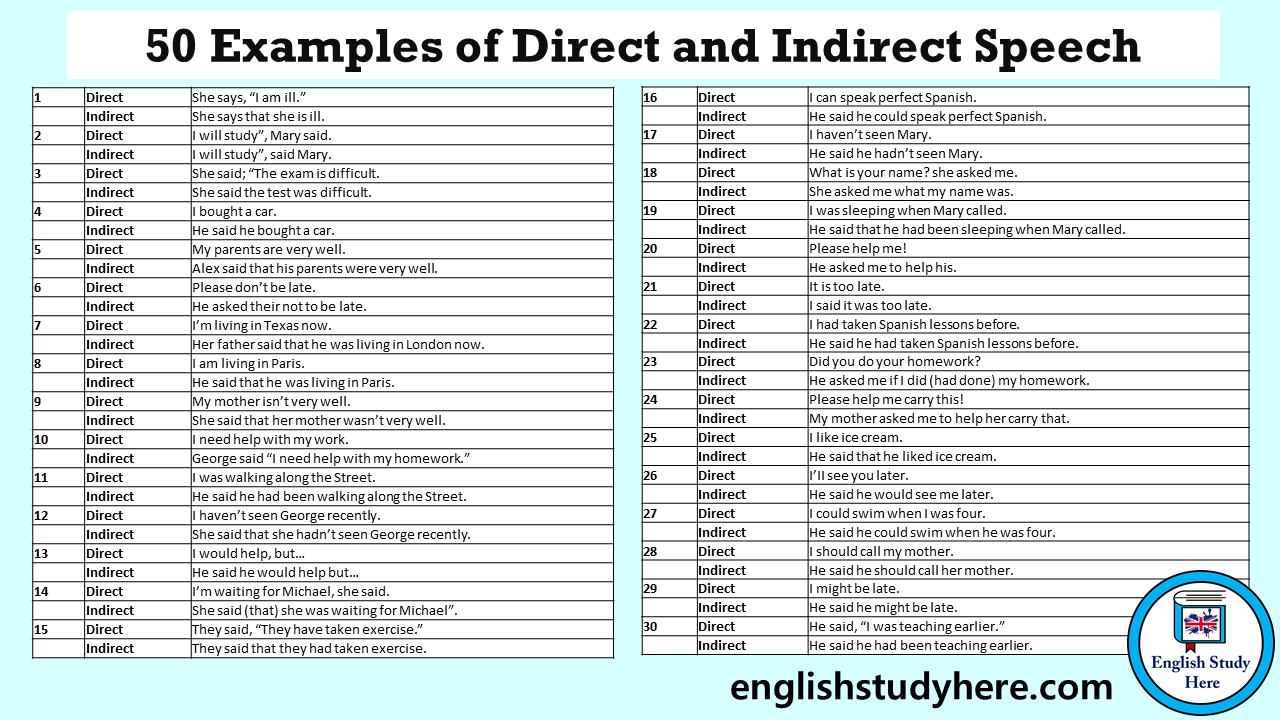
50 Examples of Direct and Indirect Speech English Study Here
Reported Speech Tense Chart. When we convert from direct speech to indirect speech, the tense of the sentence changes. See the chart below to understand direct to indirect speech tense shift. Greg said, "I am an English teacher." Greg said that he was an English teacher. Edward said, "I am watching the news."
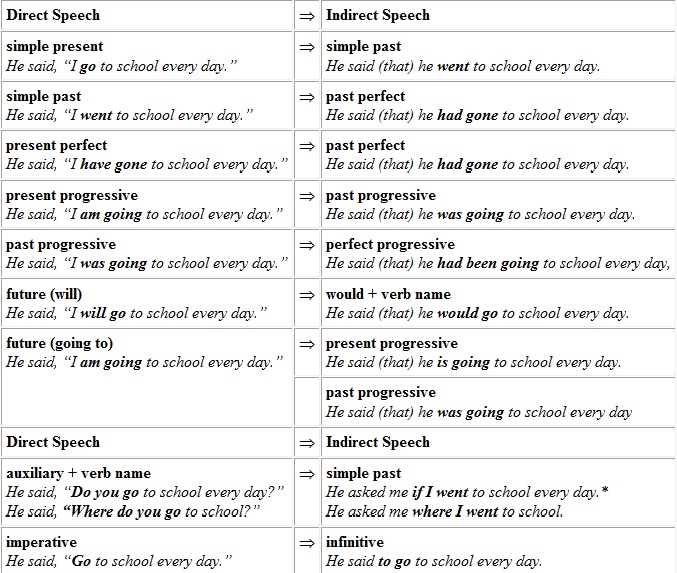
FJ HLD's Virtual ESL Classroom DIRECT & INDIRECT SPEECH
Direct speech is the ones that the person establishes himself / herself. Usually used in writing language such as novels, stories etc. Transferring the sentence that someone else says is called indirect speech. It is also called reported speech. Usually, it is used in spoken language. If the transmitted action is done in the past, the sentence.

EASY WAY TO UNDERSTAND DIRECT AND INDIRECT SPEECH RULES Readmyhelp
Direct and Indirect Speech Rules Chart Let us look at a basic chart of the direct and indirect speech that will help us understand the rules of converting one type to another easily. The basic characteristic of this chart is that it requires an understanding of the Subject noun, pronoun, its reporting verb and speech clause and conjunction.

how to write direct and indirect speech in english
A. Assertive Sentence Conversion Rules. To convert Assertive sentences into indirect speech the following rules are applied. (a) No comma and Inverted comma in Indirect Speech, only full stop at the end. (b) Reporting Verbs changed from Direct Speech to Indirect Speech; 'say - say', 'says - says', 'said - said', 'said to.

20 sentences of direct and indirect speech English Grammar Here
To change a sentence of direct speech into indirect speech there are various factors that are considered such as reporting verbs, modals, time, place, pronoun, tense, etc. we will take up all the factors one by one. Rule 1 - Direct To Indirect Speech Conversion - Reporting Verb 1.

50 Examples of Direct and Indirect Speech Englishan
March 23, 2019 Are you having trouble understanding the difference between direct and indirect speech? Direct speech is when you quote someone's exact words, while indirect speech is when you report what someone said without using their exact words.

DIRECTINDIRECT SPEECH Global ENGLISH CREATIVITY
1. Simple Present to Simple Past Direct: He said, "The boy goes home." Indirect: He said that the boy went home. 2. Present Continuous to Past Continuous Direct: Ram said, "I am reading a book." Indirect: Ram said that he was reading a book. 3. Present Perfect to Past Perfect Direct: The girl said, "I have lost my pen."

DIRECT AND INDIRECT SPEECH Reported speech, Direct and indirect speech, Indirect speech
Indirect: She exclaimed ensure it was very beautiful. Wie to remember the difference. The basic tip to recognize the difference between direct and indirect speak is that in case of direct speech we use inverted commas which are not used in case of indirect speech. Further, we use the word 'that' in overview, in indirect speech.
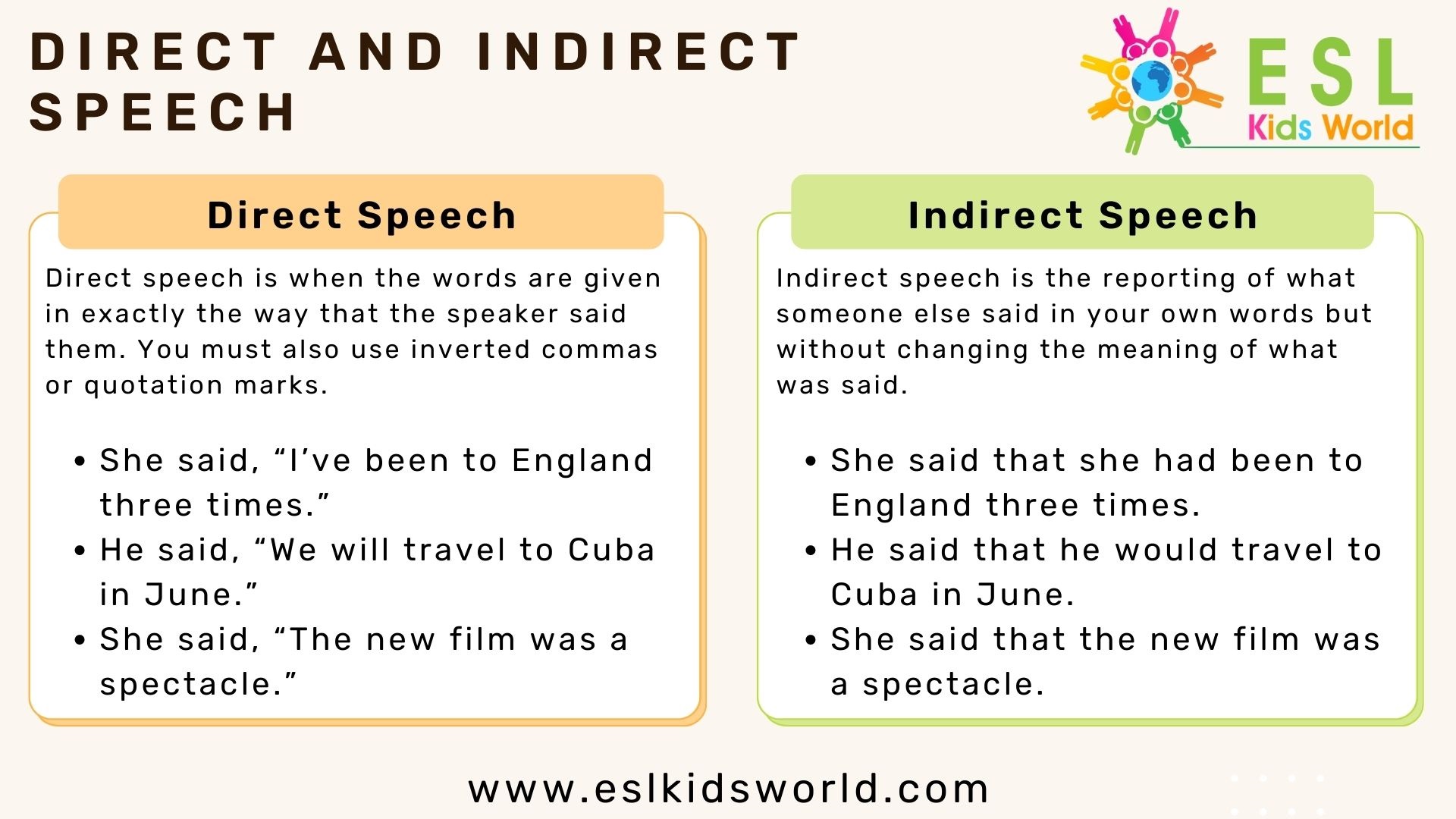
Direct and Indirect Speech Examples Direct Speech Rules ESL Kids World
Rule 1 - Direct To Indirect Speech Conversion - Reporting Verb When the reporting verb of direct speech is in past tense then all the present tenses are changed to the corresponding past tense in indirect speech. Direct to indirect speech example: Direct: She said, 'I am happy'. Indirect: She said (that) she was happy.
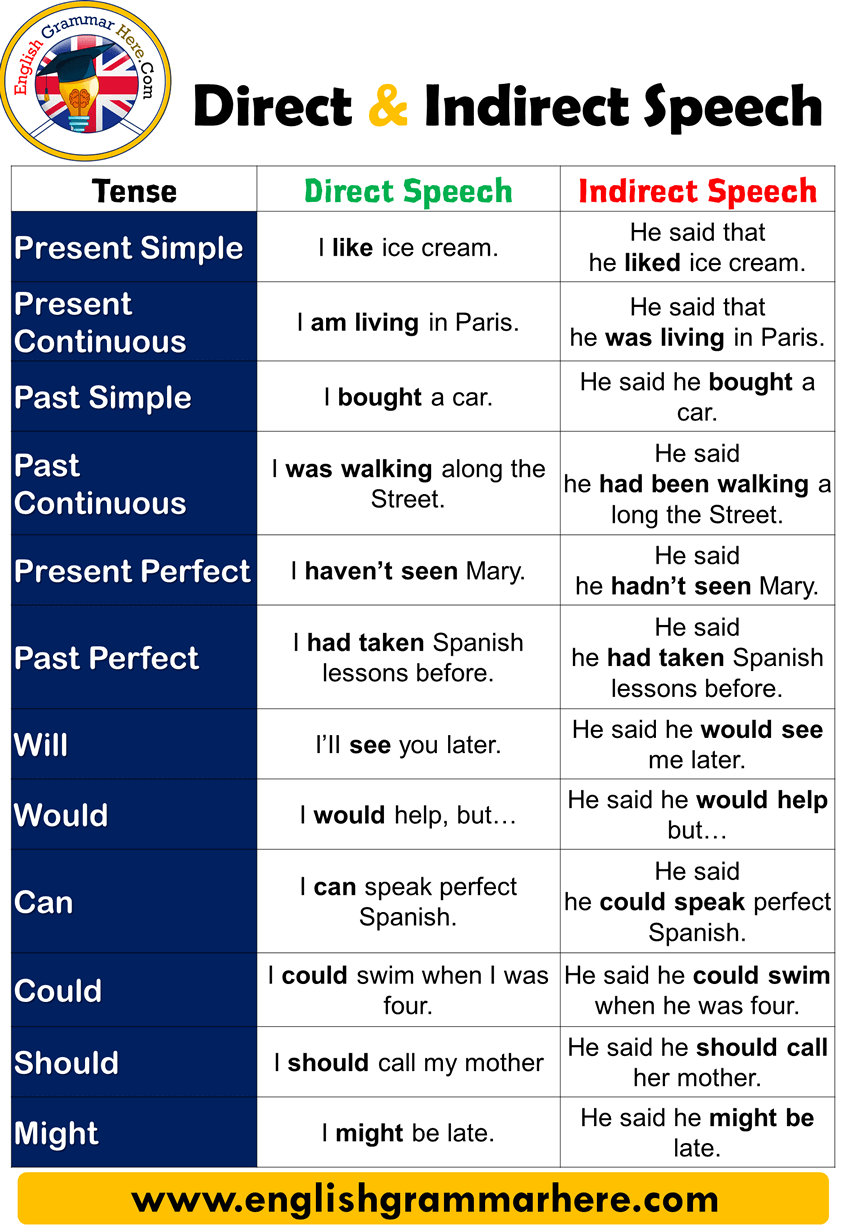
Direct & Indirect.
Indirect: She proposed to go to the mall the next day. Direct: The student said, "let me come in". Indirect: The student said that he might be allowed to come in. Direct: He said to us, "Let us all go out and party as it is my birthday". Indirect: He suggested that we should all go out and party as it was his birthday.

Direct And Indirect Speech Rules Chart Pdf Chart Walls
Some basic rules for converting direct speech into indirect speech: Rule 1: "No inverted commas." The reported speech does not come into inverted commas or quotation in an indirect speech. Example: Direct: He said, "I have completed my assignments yesterday." Indirect: He said that he had completed his assignments the previous day.
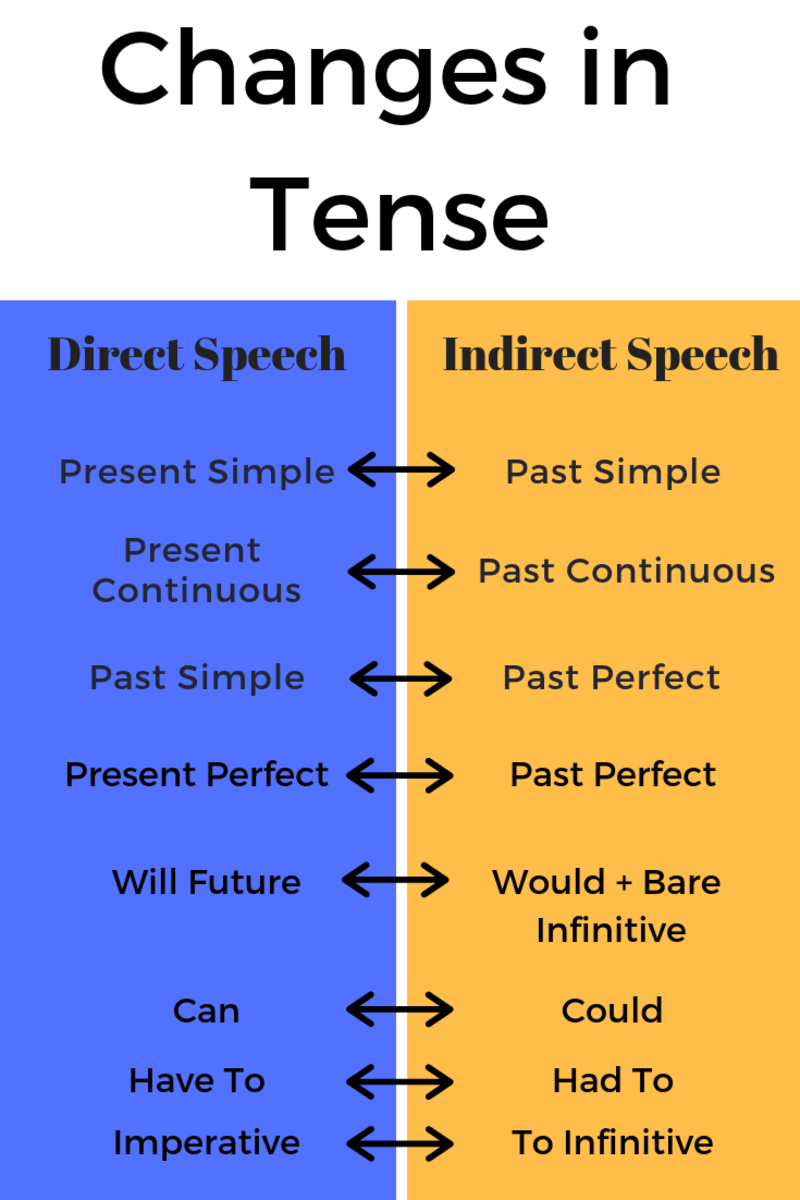
Direct and Indirect Speech With Examples and Explanations Owlcation
Direct and Indirect Speech Rules Below, we are sharing the rules to make changes from Direct to Indirect speech. The changes of Direct and Indirect speech depend on some factors like modals, reporting verb, place, time, tense, pronoun etc. You can check the complete information of changes in Direct and Indirect speech.

Direct and Indirect Speech, Definition and Rules Chart PDF
What is Direct and Indirect speech? Rules for converting Direct speech to Indirect speech Rules for converting Indirect speech to Direct speech Chart of Direct and Indirect Speech Rules Examples of Direct and Indirect speech How to Use Reporting Verbs in Direct and Indirect Speech Conclusion What is Direct and Indirect speech?
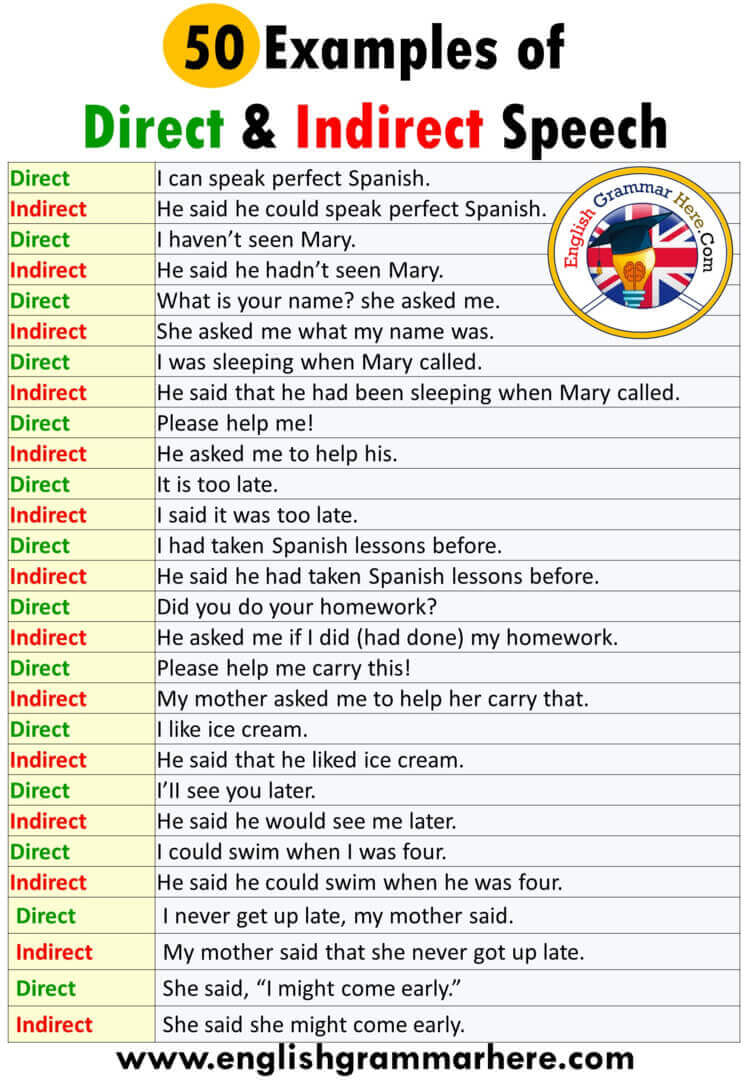
50 examples of direct and indirect speech English Grammar Here
Here are the steps involved in converting direct speech to indirect speech: Remove the quotation marks. Use a reporting verb to introduce the indirect speech. Change the tense of the verb in the quote if necessary. Change the pronouns if necessary. Use the appropriate conjunction if necessary.